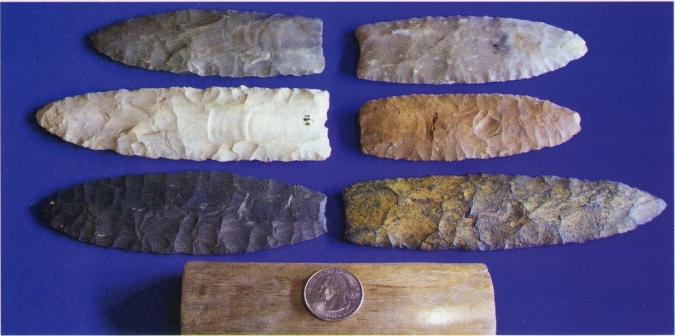by Greg L. Moore, D VM, Rhome, Texas
Originally Published in the Central States Archaeological Journal, Vol.56, No.4, pg.200
Originally Published in the Central States Archaeological Journal, Vol.57, No.1, pg.30

As most of us have come to realize with the more artifacts we handle, I have concluded that the majority of artifacts were probably utilized as tools and not as projectiles. After all, it is just common sense. Would I have thrown more lances or darts with projectiles or relied on scrapers, knives, choppers, drills and other tools in a normal day? When I open the drawer in our kitchen to retrieve a knife, I have many types to choose from depending on the use I want to accomplish with it. This selection of blades and handles in fact are logically sold as a set often inserted into a nice wooden block to be placed on the counter for easy acquisition.
When I look at an assortment of bifaces, preforms and projectiles from the Clovis Tradition, I began to see the “wooden block” and its various knives ready for use. As I have stated in previous articles, I do not believe that anything went to waste. I believe that large flaked cobbles were used as heavy choppers, that reduction flakes were utilized as limaces, flake knives, scrapers and even projectiles. With further reduction came large bifaces that were either hand held or wrapped on one end with animal hide to form a handle (figure 1 above). Further reduction of the blade would then see the biface setup for fluting while it was large and less likely to result in failure as the flute was struck.
At this point, the fluted biface was large and at times crude when compared to the fine finished Clovis projectile. With the blades insertion onto a handle, it became a well balanced large knife Large blades required more of the surface area to be included in the haft therefore transferring stress, like the shank of modern day knives, to the handle in an attempt to reduce blade fracture (figure 2 below). Because of its importance, I believe it is the handle that was the more prized of the two components. After all, many blades came and went but the handle, if of durable material, could last for years. The handle could retain information of the owner’s accomplishments by way of inscribing or tallies and could represent some component or belief of luck or success.


By comparing the similar widths of these large early fluted bifaces, I suggest that some similar material was used for the handle almost universally throughout the Clovis Tradition. Just like the consistent construction of the Clovis projectile across North America, so too could be the handle in its type, construction and hafting. This could make Clovis tools and materials interchangeable among clans. A standardized handle would call for a standardized blade width for insertion and would standardize the reduction process of the biface. For this article, I have used Pleistocene mammoth rib to construct the handles which are durable and ergonomic in the hand.
Blade replacement would be easily accomplished taking only a few minutes to unlash the reduced blade and insert the new one. The reduced blade would now be rebased and possibly additionally fluted to fit into the next smaller knife handle (figure 3 below),Insertion and binding could be accomplished in just minutes. Again, there appears to be a standard width for these smaller knife blades when you compare large numbers of fluted artifacts that seem too long and thin for projectiles and use wear suggests the blade was used as a knife. As these smaller knives were reduced from resharpening, they could again be rebased and finely flaked into deadly projectiles. This could explain some of the extensive use polish and very fine retouch seen on the base of many Clovis projectile points. Closer inspection on some Clovis projectiles will even retain evidence of previous hafting on the blade face when the blade was longer, prior to its current reduction (figure 4).


Figure 3: Please note: The largest blade pictured is a cast from the Fenn Cache. The middle blade, almost exhausted from a larger blade like the Fenn blade, is ready to be rebased and placed on the next smaller handle with a shorter haft as shown lower in the picture. The middle blade was found near Tyler, Texas and the lower Clovis was found in Ralls Co. MO.
Figure 4.
Although we will never know exactly how these artifacts were utilized, I believe that some type of “manufacturing standard” was in play even throughout most time periods and cultures. The last example I’ve pictured shows two knives and handles found under an overhang near the opening of a small cave by a friend of mine. It demonstrates the ease at which the blade could be attached to the handle and a consistency in manufacture of the blade and the handle type. Like many Late Archaic and Woodland period artifacts, the blade stem is offset to one blade face more than the other which allows a flat haft when secured to the bone handle and its angled protuberance in relation to the flat plain of the handle (figures 5 & 6 below). Although not of the Clovis Tradition, it is useful to demonstrate that the blade and hafting area was shaped to fit a “standard” handle and the intended use was that of a knife and not a projectile.


Figure 6. (bottom)
“Used by Permission of the Author”
To learn more about or to join the Central States Archaeological Society, click here:CSASI.org
